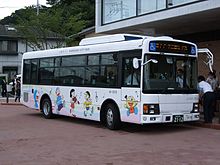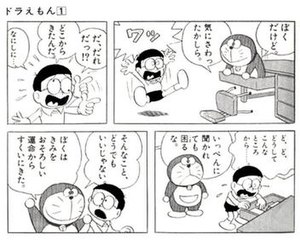Doraemon
 Doraemon possesses a fourth-dimensional pocket from which he can acquire various kinds of futuristic tools, gadgets, and playthings from a future department store. Doraemon originally had ears but they were bitten off by a robotic mouse in the 22nd century. As a result, he developed a morbid fear of mice despite being a robotic cat. He also has the tendency to panic during emergencies, characterized by him frantically trying to pull out a very much-needed tool from his pocket, only to produce a huge assortment of unrelated household items. Doraemon's favourite food is dorayaki, a Japanese treat filled with red bean paste.
Doraemon possesses a fourth-dimensional pocket from which he can acquire various kinds of futuristic tools, gadgets, and playthings from a future department store. Doraemon originally had ears but they were bitten off by a robotic mouse in the 22nd century. As a result, he developed a morbid fear of mice despite being a robotic cat. He also has the tendency to panic during emergencies, characterized by him frantically trying to pull out a very much-needed tool from his pocket, only to produce a huge assortment of unrelated household items. Doraemon's favourite food is dorayaki, a Japanese treat filled with red bean paste.Doraemon is considered a substandard product because many of his robotic features (ie. radar whiskers and cat-calling bell) malfunctioned after production. One can turn off Doraemon by pulling his balloon tail.
In the 2007 birthday episode, 'MS-903' is used to call Doraemon by the factory owner where Doraemon is produced.
Doraemon usually uses the phrase "nanoda".
Nobita Nobi
 Nobita is the main character of the series and the center of the story. He is a fourth grader in Tokyo's Nerima Ward and an only child. He wears glasses, a red or yellow polo shirt with a white collar, and blue shorts. Nobita's character flaws are endless: he is lazy, uncoordinated, dim-witted, frail, plain-looking, unlucky, and bad at sports. Nobita's typical day consists of arriving late on classes, scoring zeros in his tests, getting lectured by his teacher, being bullied by his classmates Gian and Suneo, falling into curbside rain gutters, being chased by dogs, and getting scolded by his mom for his sloth and poor academic results.
Nobita is the main character of the series and the center of the story. He is a fourth grader in Tokyo's Nerima Ward and an only child. He wears glasses, a red or yellow polo shirt with a white collar, and blue shorts. Nobita's character flaws are endless: he is lazy, uncoordinated, dim-witted, frail, plain-looking, unlucky, and bad at sports. Nobita's typical day consists of arriving late on classes, scoring zeros in his tests, getting lectured by his teacher, being bullied by his classmates Gian and Suneo, falling into curbside rain gutters, being chased by dogs, and getting scolded by his mom for his sloth and poor academic results.Despite his flaws, Nobita possesses some unique talents such as his unrivaled marksmanship and ability to weave intricate string figures. Although Nobita is usually portrayed as being cowardly, he has often risked his life to help save others or even entire civilizations (as seen in full-length stories).


